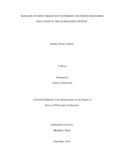
Please use this identifier to cite or link to this item:
https://hdl.handle.net/20.500.14301/271| Title: | NEPALESE STUDENT MIGRATION TO FOREIGN COUNTRIES FOR HIGHER EDUCATION IN THE GLOBALIZED CONTEXT |
| Authors: | Acharya, Krishna Prasad |
| Citation: | Acharya,K.P.(2012).Nepalese Student Migration to Foreign Countries for Higher Education in the Globalized Context |
| Issue Date: | Sep-2012 |
| Publisher: | Kathmandu University School of Education |
| School: | SOED |
| Department: | DODE |
| Level: | Ph.D. |
| Program: | PhD in Development Education |
| Abstract: | Thousands of Nepalese students annually aspire to go abroad in search of higher education. This research is a study of Nepalese student migration to foreign countries for higher education in the globalized context. The purpose of this study is to identify the trends and causes of Nepalese student migration and to explore their expectations and aspirations from the standpoint of push-pull factors. The main research question is addressed to explore the determinants of student migration. Hypotheses such as push pull, social network, age, parental income and student migration were developed. Based on the post-positivism and interpretivism paradigm, this study uses mixed methodologies. After a pilot survey, data were collected from 407 respondents selected by using stratified random sampling. Similarly, data were collected from the current student enrolment at different universities and colleges of the USA, the UK and Australia. Likewise, qualitative data were generated mainly from key participants. Regarding the secondary data, the main sources were MoE, other government agencies, and national and international organizations. The correlation, K-W, and t-tests were employed to interpret and analyse data with the help of SPSS-16. Similarly, interpretative paradigm was used to analyse qualitative data to present them in a thematic sequence with respect to each research question. The main push factors include very limited employment opportunities, low quality education, limited career opportunities, unavailability of choice of subject, lack of modern lab, library and research facilities, political instability, and Bandh/Hartal. Education and earning opportunities, earning opportunities, quality education (recognized degree), availability of choice of subject, reputed university; lab and research facilities; career opportunities; support from relatives and friends, independence and quality of life were pull factors. Personal factors and students’ expectations and aspirations also influenced student mobility. The number of students-both Nepalese and international pursuing higher education abroad has been increasing nationally and globally. It was found that one dominant cause of migration was low earning opportunities so students were highly motivated for earning while they get learning opportunities at the destination. There was no significant difference in the perceptions of students towards push-pull and age factors. High parental income was not a determinant factor of migration. The study reveals that social capital also influences migration. It was found that migration tendency differed with age. The t-test indicated that current and potential students had similar responses. Although, Nepalese students’ choice of destination countries was found to be more than 50 countries, the preferred three destinations for aspiring students were cited as the UK (48.30 percent), USA (25.62 percent) and Australia (11.82 percent). Qualitative data revealed that high expectations, aspirations and motivation prompted students to go abroad. Hence, data fully supported the push-pull theory and social network theory. The study concludes that student migration is inevitable in this globalized world. It was found that the main motive for student migration was to obtain a recognized degree in order to get higher rate of return from that degree. However, Nepalese students were also motivated by work and study at the destination. Nowadays, the brain drain debate has been converted into brain gain in the globalized context. Finally, higher education policy, human resources planning, and policy to attract international students to Nepal are recommended. Key words: Student migration, student mobility, higher education, globalization. |
| URI: | https://hdl.handle.net/20.500.14301/271 |
| Appears in Collections: | Theses |
Files in This Item:
| File | Description | Size | Format | |
|---|---|---|---|---|
| Krishna PrasadAcharya PhD.pdf | 3.52 MB | Adobe PDF |  View/Open |
Items in DSpace are protected by copyright, with all rights reserved, unless otherwise indicated.